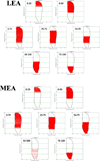Implementation of topographically constrained connectivity for a large-scale biologically realistic model of the hippocampus
- PMID: 23366151
- PMCID: PMC4172365
- DOI: 10.1109/EMBC.2012.6346190
Implementation of topographically constrained connectivity for a large-scale biologically realistic model of the hippocampus
Abstract
In order to understand how memory works in the brain, the hippocampus is highly studied because of its role in the encoding of long-term memories. We have identified four characteristics that would contribute to the encoding process: the morphology of the neurons, their biophysics, synaptic plasticity, and the topography connecting the input to and the neurons within the hippocampus. To investigate how long-term memory is encoded, we are constructing a large-scale biologically realistic model of the rat hippocampus. This work focuses on how topography contributes to the output of the hippocampus. Generally, the brain is structured with topography such that the synaptic connections formed by an input neuron population are organized spatially across the receiving population. The first step in our model was to construct how entorhinal cortex inputs connect to the dentate gyrus of the hippocampus. We have derived realistic constraints from topographical data to connect the two cell populations. The details on how these constraints were applied are presented. We demonstrate that the spatial connectivity has a major impact on the output of the simulation, and the results emphasize the importance of carefully defining spatial connectivity in neural network models of the brain in order to generate relevant spatiotemporal patterns.
Figures




Similar articles
-
The role of topography in the transformation of spatiotemporal patterns by a large-scale, biologically realistic model of the rat dentate gyrus.Annu Int Conf IEEE Eng Med Biol Soc. 2013;2013:5950-3. doi: 10.1109/EMBC.2013.6610907. Annu Int Conf IEEE Eng Med Biol Soc. 2013. PMID: 24111094 Free PMC article.
-
Implementation of activity-dependent synaptic plasticity rules for a large-scale biologically realistic model of the hippocampus.Annu Int Conf IEEE Eng Med Biol Soc. 2012;2012:1366-9. doi: 10.1109/EMBC.2012.6346192. Annu Int Conf IEEE Eng Med Biol Soc. 2012. PMID: 23366153 Free PMC article.
-
A Continuous Attractor Model with Realistic Neural and Synaptic Properties Quantitatively Reproduces Grid Cell Physiology.Int J Mol Sci. 2024 May 31;25(11):6059. doi: 10.3390/ijms25116059. Int J Mol Sci. 2024. PMID: 38892248 Free PMC article.
-
Hippocampal place cells: parallel input streams, subregional processing, and implications for episodic memory.Hippocampus. 2006;16(9):755-64. doi: 10.1002/hipo.20203. Hippocampus. 2006. PMID: 16883558 Review.
-
Episodic memory: Neuronal codes for what, where, and when.Hippocampus. 2019 Dec;29(12):1190-1205. doi: 10.1002/hipo.23132. Epub 2019 Jul 23. Hippocampus. 2019. PMID: 31334573 Review.
Cited by
-
The role of topography in the transformation of spatiotemporal patterns by a large-scale, biologically realistic model of the rat dentate gyrus.Annu Int Conf IEEE Eng Med Biol Soc. 2013;2013:5950-3. doi: 10.1109/EMBC.2013.6610907. Annu Int Conf IEEE Eng Med Biol Soc. 2013. PMID: 24111094 Free PMC article.
-
Implementation of the excitatory entorhinal-dentate-CA3 topography in a large-scale computational model of the rat hippocampus.Annu Int Conf IEEE Eng Med Biol Soc. 2014;2014:6581-4. doi: 10.1109/EMBC.2014.6945136. Annu Int Conf IEEE Eng Med Biol Soc. 2014. PMID: 25571504 Free PMC article.
-
Towards a large-scale biologically realistic model of the hippocampus.Annu Int Conf IEEE Eng Med Biol Soc. 2012;2012:4595-8. doi: 10.1109/EMBC.2012.6346990. Annu Int Conf IEEE Eng Med Biol Soc. 2012. PMID: 23366951 Free PMC article.
-
A million-plus neuron model of the hippocampal dentate gyrus: Dependency of spatio-temporal network dynamics on topography.Annu Int Conf IEEE Eng Med Biol Soc. 2015;2015:4713-6. doi: 10.1109/EMBC.2015.7319446. Annu Int Conf IEEE Eng Med Biol Soc. 2015. PMID: 26737346 Free PMC article.
-
The contribution of relative activation levels between populations of cells to network activity in a large-scale biologically realistic model of the hippocampus.Annu Int Conf IEEE Eng Med Biol Soc. 2013;2013:5962-5. doi: 10.1109/EMBC.2013.6610910. Annu Int Conf IEEE Eng Med Biol Soc. 2013. PMID: 24111097 Free PMC article.
References
-
- Andersen P, Bliss TVP, Skrede KK. Lamellar Organization of Hippocampal Excitatory Pathways. Experimental Brain Research. 1971;13:222–238. - PubMed
-
- Dolorfo CL, Amaral DG. Entorhinal cortex of the rat: topographic organization of the cells of origin of the perforant path projection to the dentate gyrus. The Journal of Comparative Neurology. 1998 Aug;398(1):25–48. - PubMed
Publication types
MeSH terms
Grants and funding
LinkOut - more resources
Full Text Sources
